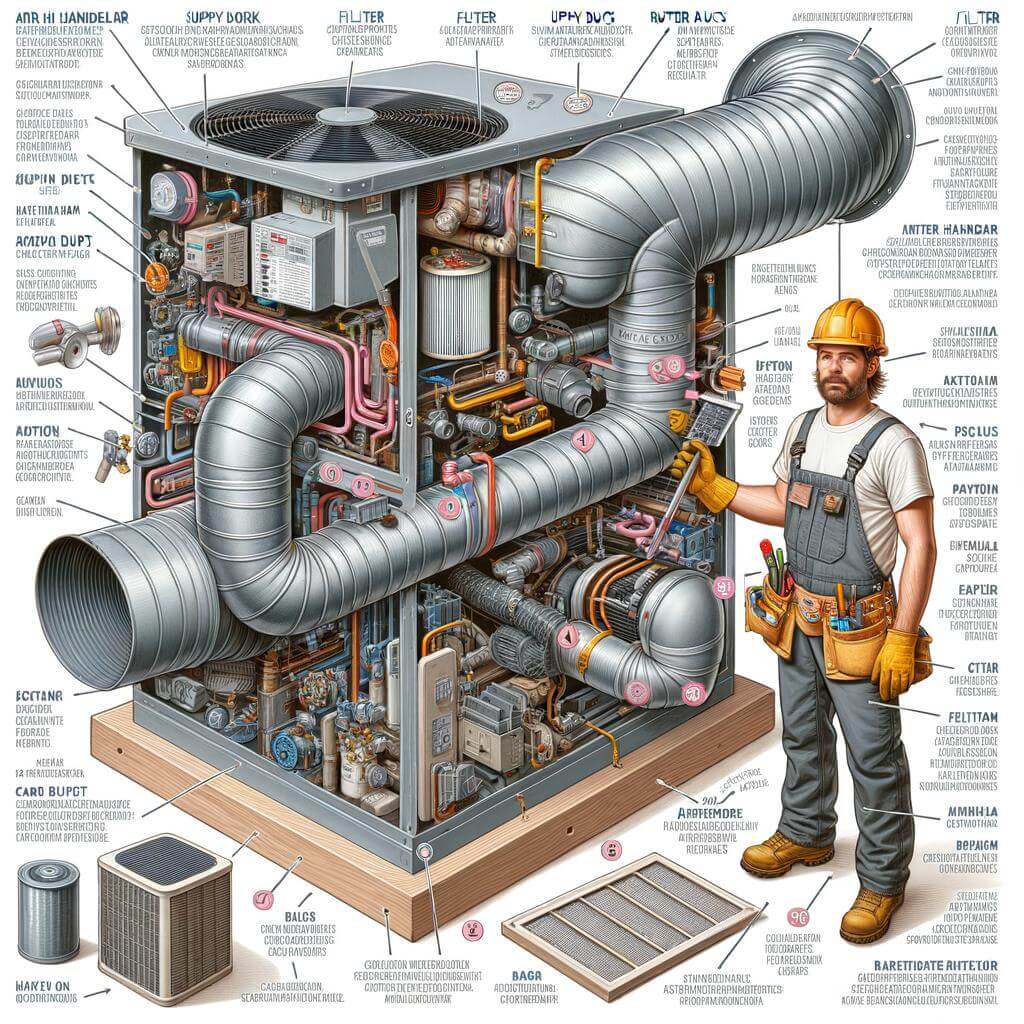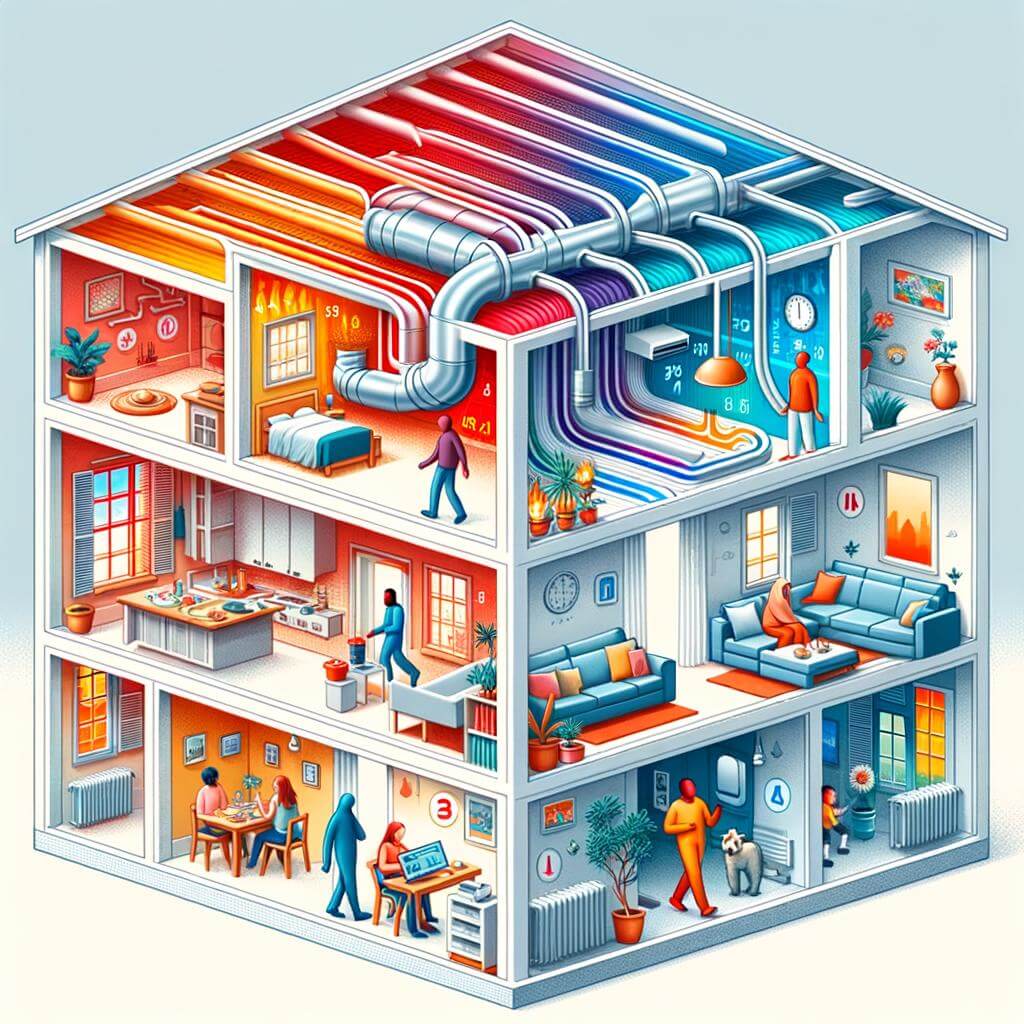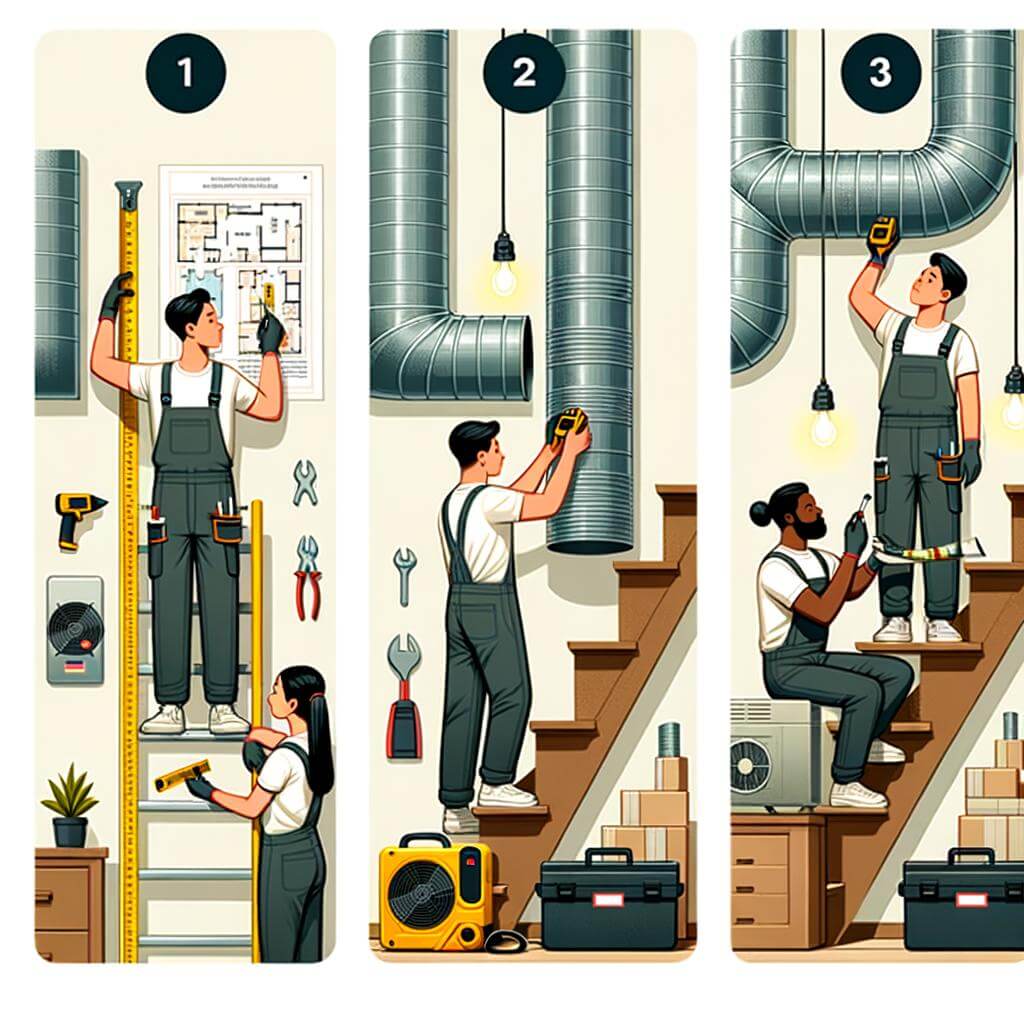Welcome to our comprehensive post on “Understanding the Role of Ductwork in Your Home A/C System”. This piece aims to shed light on the intricate yet vital part of your residential cooling system – the ductwork. This fundamental component is often overlooked, despite the crucial role it plays in efficiently cooling your home. Whether you’re troubleshooting an issue or looking to optimize your home climate, having basic knowledge about your A/C ductwork can be incredibly beneficial. This post will provide detailed, expert insights into how ductwork functions, which could potentially save you time, energy, and money. So, sit back, relax, and prepare to dive deep into the world of home A/C systems. Whether you’re a seasoned homeowner or someone new to the realm of home maintenance, you’ll find this information useful and easy to understand.
Basics of Ductwork in Home A/C Systems
If you’ve ever wondered what part your ductwork plays in your home A/C system, the answer is quite a significant one. The ductwork in your home is essentially the arteries of your cooling setup, transporting chilled air from the air conditioning unit to the various rooms in your home. Simply put, without it, your A/C system would struggle to function correctly. This network of passages lets air flow freely and steadily, ensuring that your entire home stays comfortable and cool.
In a typical A/C system setup, you have oxygen supply ducts and return ducts. The former carries and dispenses treated air into your indoor space while the latter retrieves the indoor air back to the A/C unit for re-cooling and circulation. Ducts are typically constructed out of materials like fiberglass or metal, and can often be found in the attic, crawl spaces, or the basement of your home. It’s essential that these ducts are well-kept and not leaking, as poorly maintained or damaged ductwork can lead to inefficiency in your A/C system like heated rooms, high electricity bills, and poor indoor air quality.
| Part of Ductwork | Description |
|---|---|
| Supply Ducts | They carry and distribute cooled air into indoor spaces. |
| Return Ducts | They return air back to the A/C unit to be re-cooled and circulated. |
- Oxygen Supply Ducts: These ducts carry and distribute cooled air into your home to reduce the temperature. They can be found in walls, ceilings, and floors.
- Return Ducts: These ducts return air to the A/C unit to be re-cooled and circulated. They are typically larger and can be found in each room that has supply ducts.

Recognizing the Importance of Ductwork in Climate Control
The heart of your home’s air conditioning system isn’t the unit sitting outside, but rather the network of ducts running behind your walls and ceilings. Your HVAC system might produce perfectly chilled air, but without efficient and well-maintained ductwork, you won’t feel the full cooling benefits. The speed, energy efficiency, and effectiveness of your home’s AC is highly dependent on this behind-the-scenes network. Torn or leaky ducts can result in significant loss of cool air, leading to an inefficient system and higher energy bills.
| Additional Pressure | Higher Energy Bills |
|---|---|
| Leaky ducts force the system to work harder, thereby increasing energy consumption and reducing the lifespan of the system. | When ductwork is compromised, your HVAC has to operate longer to reach the set temperature which leads to greater energy use and higher bills. |
Such problems can be addressed by periodic maintenance and inspection of the ductwork. Regular duct cleaning can help remove dust and grime that builds up over time, affecting the air quality in your home. Additionally, insulating ducts can help prevent heat loss in the winter and heat gain in the summer, further adding to system efficiency. By ensuring ductwork is properly sealed and insulated, you can achieve a comfortable indoor environment, conserve energy, and save money on heating and cooling costs.
Below are some DIY tips to maintain optimal ductwork performance:
- Regular inspection: Look for holes, leaks, or loose connections and have them corrected immediately.
- Sealing: Use mastic, metal tape, or aerosol-based sealants to fix small leaks.
- Insulation: Ductwork in unheated spaces should be insulated to prevent temperature fluctuations.
- Cleanliness: Regular cleaning and changing filters can greatly improve air quality and system efficiency.
Remember, efficient ductwork is not just about comfort, it’s about optimizing the function of your home’s HVAC system, saving money, and creating a healthier indoor environment.
Analyzing Different Types of Ductwork: Which is Best for Your Home?
Types of Ductwork
The first type of ductwork is flexible, also known as ‘flex’. As the name suggests, this type of ducting is flexible and can be easily shaped to fit around obstacles in your home such as joists or other structural members. This makes it a great option for houses with complicated layouts or cramped spaces. However, the downside to flex ducting is that the ribs inside the ductwork can interfere with airflow, reducing your A/C system’s efficiency.
On the other hand, we have rigid ductwork. This type of ducting is made from solid materials, such as galvanized steel, fiberglass, or aluminum. Rigid ductwork is much more efficient at moving air because it has a smooth interior that reduces air friction and heat loss. However, it is more challenging to install than flex ducting and it doesn’t bend, so it might be a problematic choice for houses with a lot of physical constraints.
| Type of Ductwork | Advantages | Disadvantages |
| Flexible | Adaptable, easy to install | Reduces A/C system’s efficiency |
| Rigid | Efficient airflow, minimum heat loss | Installation challenges, inflexible |
Certainly, deciding on the best ductwork for your home would require considering these benefits and drawbacks. The complexity of your home’s layout and your HVAC system’s requirements will directly influence which type ofductwork is most appropriate for your setting. Consulting with a reliable HVAC professional can help you determine the best ductwork type for your home, keeping your A/C system running efficiently and ensuring that conditioned air is effectively distributed throughout your living space.
Importance of Regular Ductwork Maintenance
A balanced and efficient home A/C system is the result of a combination of various aspects, with the ductwork being a major component of this. As the conduit for cooled air, ductwork has a significant role in maintaining comfort in households. While you may feel the change in temperature with your A/C system working, you may not always see what’s going on within the hidden network of ducts.
The number one importance of regular ductwork maintenance is to ensure efficient airflow in your home. Over time, ducts can accumulate dust, debris, and even become infested with pests, all of which can restrict airflow and cause your A/C system to work harder, increasing energy consumption. Regular maintenance and cleaning prevent such problems, keep your system running optimally and can significantly reduce utility bills.
- Improved air quality: Long periods of neglect can turn your ductwork into breeding grounds for allergens, mold, and bacteria. If left unaddressed, these can be diffused inside your house along with the cooled air, leading to potential health hazards. Regular maintenance ensures good indoor air quality.
- Longer system lifespan: Regular maintenance can prevent premature system breakdown. When ductwork is not cleaned regularly, it could lead to the accumulation of particles that can cause serious damage to your system, ultimately reducing its lifespan.
- Comfort: Clean and efficient ductwork ensures that cooled air is equally distributed in your home, preventing hot spots and cold zones. This translates into a more comfortable living environment.
Moreover, the is further emphasized when it comes to energy consumption. Keeping your ductwork clean and well-maintained can help reduce your home’s energy use and contribute to environmental sustainability. An EPA study claims that by cleaning just 15% of one HVAC system, that system will yield a 20% reduction in energy consumption which can save a lot of money over time.
A professional ductwork maintenance service includes inspection, cleaning, sealing, repair, or even replacement if needed. A thorough inspection will help identify any leaks, blockages or damage and also include cleaning and disinfection of your entire duct system.
| Maintenance Aspect | Benefit |
|---|---|
| Inspection | Identifies early signs of ductwork issues |
| Cleaning | Ensures efficient airflow and good indoor air quality |
| Sealing | Reduces leakage, maintains optimal air pressure in system |
| Repair/Replacement | Maintains the overall performance and lifespan of the Home A/C system |
In summary, if you want to optimize your home comfort and lower your energy bills, don’t overlook the role of ductwork in your home A/C system. Regular maintenance, professional inspection, and timely repairs can have long-term benefits.
Common Issues in Ductwork and Their Impact on A/C Efficiency
One prevalent issue that affects the performance of air conditioning units is the improper sizing of ductwork. When ducts are either too small or too large in relation to your A/C system, it interferes with the displacement of air, leading to an overall drop in efficiency. Too small ducts constrict airflow, causing your unit to work overtime and contributing to premature wear and tear. On the other hand, too large ducts can lower air velocity, leading to poor air distribution and uncomfortable conditions in your home.
- Leaky ductwork: Small holes and cracks that may appear over time allow cooled air to escape outdoor or to unconditioned areas of your house. This means your A/C unit must work harder to maintain the indoor temperature, which can increase your energy bill.
- Ductwork Insulation Issues: This prevents the air from maintaining its temperature as it moves around your home. Poorly insulated or uninsulated ductwork can result in significant energy losses.
- Obstruction in Ducts: Sometimes, dust and debris can accumulate inside ducts, which can block or reduce airflow. This eventually makes your unit work harder and consume more energy.
Ductwork problems don’t just affect the efficiency and performance of your A/C unit; they also impact indoor air quality and comfort. Dust and debris accumulation can mix with the air blown from the A/C unit, leading to dust and allergen circulation throughout your home. Improperly sized ducts can also create uneven cooling, leaving some rooms in your home hotter or colder than others.
| Common Ductwork Issue | Impact |
|---|---|
| Improper Sizing | Reduction in A/C efficiency, uneven cooling, increased energy consumption |
| Leaky Ductwork | Loss of cooled air, increased energy costs, reduced A/C functionality |
| Insulation Issues | Loss of energy, Failure to maintain air temperature, heavier workload on A/C unit |
| Obstruction in Ducts | Reduced airflow, increased energy usage, potential damage to A/C unit |

Expert Advice: Proper Ductwork Installation and Optimization Tips
Proper Ductwork Installation Tips
When handling ductwork, remember it plays a crucial role in making sure your air conditioning system is efficient and maintains an even temperature throughout the home. Here are expert tips to guide you in this process:
- Ensure you size your ductwork appropriately. The size should correspond to the air conditioning system’s capacity.
- Insulate your ducts well to prevent energy loss. This will also help keep the cool air from becoming warm, ensuring you get the most out of your A/C system.
- Avoid unnecessary bends and turns. They can lead to airflow restriction and reduce system efficiency.
- Finally, install duct supports correctly to avoid strain, which could lead to leaks.
Ductwork Optimization Tips
Once you have the ductwork installed correctly, the following tips can help to optimize its functionality for your A/C system:
- Regular cleaning of the ductwork is essential to prevent the accumulation of dust and other particulates that can reduce system efficiency.
- Using a qualified technician to conduct routine check-ups can help identify and fix potential issues before they become problematic.
- If there are rooms that are not in use, close the air registers to improve efficiency and lower cost of operation.
The table below summarizes these tips:
| Action | Purpose |
|---|---|
| Appropriate sizing of ductwork | Ensures system capacity matches the ductwork size to aid efficiency |
| Insulating ducts | Prevents energy loss and maintains temperature of cool air |
| Avoiding unnecessary duct bends/turns | Prevents airflow restriction and maintains system efficiency |
| Correct installation of duct supports | Prevents strain which can lead to leaks |
| Regular duct cleaning | Prevents dust accumulation and maintains system efficiency |
| Routine check-ups by a qualified technician | Helps identify and rectify potential issues before they become problematic |
| Closing air registers in unused rooms | Improves system efficiency and lowers cost of operation |
In Conclusion
In conclusion, understanding the role of ductwork in your home A/C system is not only beneficial in maximizing energy efficiency but also in ensuring a comfortable living environment. A well-maintained ductwork translates into balanced temperature levels, improved air quality, and fewer repairs. By conducting routine inspections and timely maintenance, you can keep your A/C system running smoothly and effectively. However, remember that ductwork maintenance might require professional expertise to handle certain complexities. Thus, secure the services of a certified HVAC professional for a comprehensive examination and subsequent repairs if necessary. Our journey into the intricacies of A/C ductwork emphasizes its critical role in creating a pleasant and heat-efficient home. Knowledge of your home’s A/C system allows you to make informed decisions which eventually translate into a comfortable and happy living experience.




